Last Updated on November 18, 2025 by Ewen Finser
The rise and rise of the creator economy has meant that partnering with an affiliate or an influencer has become a great tactic for increasing sales or drumming up interest in your business. But managing those relationships…whew. There’s drafting out contractuals, shipping products, following up, tracking progress, and so on and so on.
As an Amazon seller, I’m always looking for something that helps with all or some of this and more. I ended up taking a long hard look at Statusphere and Levanta, two of the biggest players in the influencer/affiliate platforms. And I’ve come to a firm conclusion on which one works best for me and my business. Although, I must say, both have great benefits.
Statusphere vs Levanta: Key Differences
- Statusphere uses AI to automatically connect you/converse with influencers, whereas Levanta doesn’t automate these processes, but does allow you a lot more control over who you choose to contact.
- Statusphere has a very stripped-back AI that’s super easy to use, while Levanta is more robust because it gives you control over every step of the process. You can hand-pick who you work with from a network of over 40,000 vetted creators, affiliates, and publishers, track actual sales down to the product level, and manage commissions and payouts.
- Statusphere’s pricing is steep even on the lowest plan, whereas Levanta is built to grow with you offering a feature-rich platform that can support larger teams and more complex partnership strategies as your business scales.
The Bottom Line:
While on the face of it, Statusphere and Levanta are very similar, there are some big differences in terms of what each one focuses on.
In my opinion, Statusphere uses AI to make life for bigger brands a lot easier. Most processes are automated for you, and so you can let go of many of the smaller tasks involved in managing influencers. If you want to eliminate tasks from your to-do list, especially if you work with a large team, Statusphere makes sense. But this is very much reflected in the pricing.
I think Levanta is the strongest contender for Amazon sellers or those looking to break into the Amazon market. Not just because it’s more affordable, but because it allows businesses a lot of control over the affiliates, influencers, and publications they want to contact, and is designed to scale with you as you grow. I also appreciate how easy they make it to understand how products and affiliates are performing, helping you grow your Amazon presence without relying solely on risky ad spend.
If you’re a bigger brand with a bigger budget and you need to free some time, Statusphere is a great choice. But if you have a brand focused on Amazon sales growth, I’d recommend Levanta.
Levanta assembled this report to help digital merchants navigate the new AI-shaped buying journey. Discover why creators now drive the clicks AI can’t and how to turn that into revenue.
Statusphere vs. Levanta: Head-to-Head Comparison
Statusphere | Levanta | |
Purpose | Connecting with influencers for easier marketing across social media platforms like TikTok and Instagram | Influencer and affiliate marketing for external traffic on Amazon |
Best For | Those wanting to connect to the right influencers to advertise products | Brands with validated products and budget for marketing |
Pricing | From $3,500 per month | $150 – $750 p/m + a percentage of affiliate sales |
Learning Curve | Very slight; easy to use right from the start | A small learning curve, but easy to use in general, offers more customization |
Biggest Value | Influencer matching and management, and clear analytics | Easy to connect with influencers, publications, and others |
When to Use Statusphere
Statusphere is an AI-driven platform aimed at microinfluencers or business owners working with influencers. Once you sign up, the platform matches you with creators within your niche, without you having to seek them out yourself.
Essentially, Statusphere takes the work out of having to build relationships with influencers. It sends follow-up emails. It responds to influencers. It even takes care of some of the shipping/fulfillment to influencers. With this platform, you can decide to sit back and observe the results.
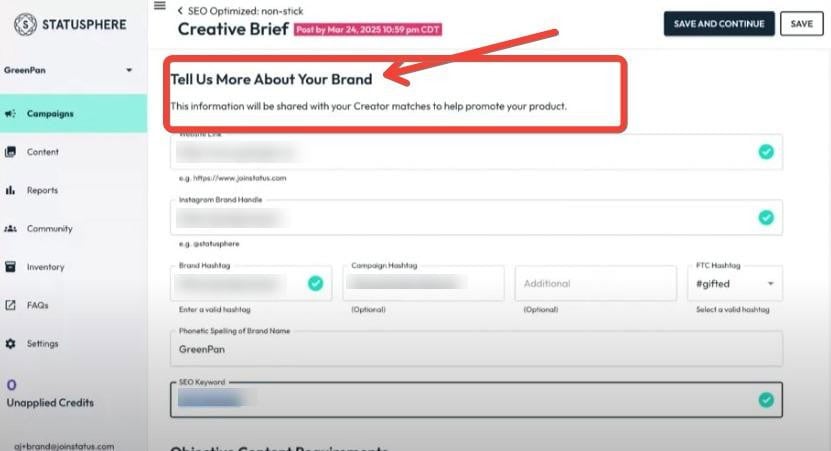
I like the simple, very user-friendly UI. Obviously, I can’t see it from an influencer perspective, but it seems designed to be straightforward for everyone involved. The AI even automatically checks the creator’s posts, accepting or rejecting them on your behalf, so you don’t have to worry about posts that don’t fit the brief (or importantly, posts that don’t fit copyright law and FTC guidelines).
When you create a campaign, it’s very easy to put in the key details, which helps Statusphere match your products with the right influencers to create a natural partnership.
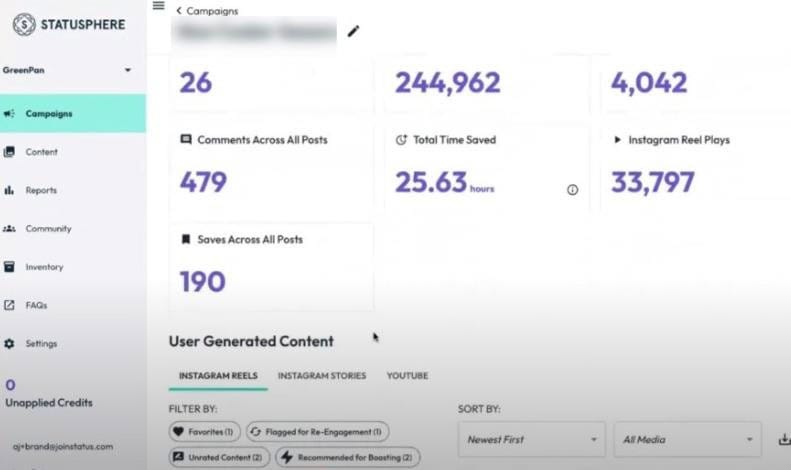
You can track your campaign performance using Statusphere’s analytics. It’s so easy to understand that I found myself enjoying the idea of reviewing my campaign performance reports; as I run everything myself, it’s useful to quickly see how influencer posts are doing, how many saves and comments there have been across all posts, and (I particularly like this) how much time I’ve saved using the platform.
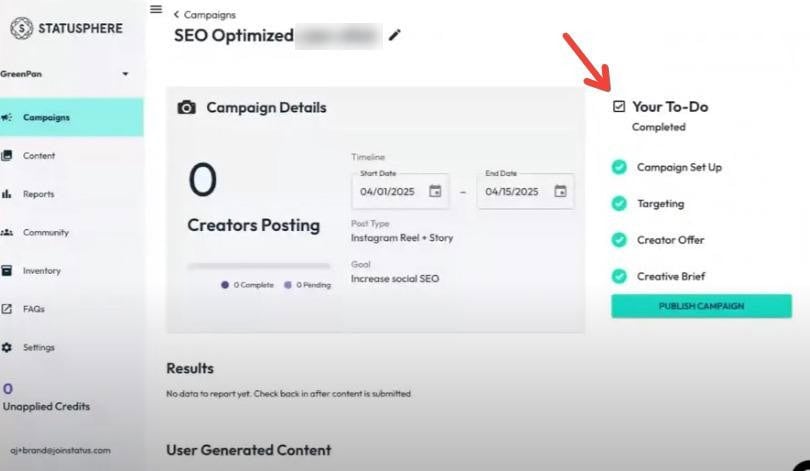
I also like the to-do list function on the Campaign page, which makes it very easy to figure out what I need to do next. As I’m working alone, I don’t have anyone telling me what I need to do next, so it’s nice to have a clear set of instructions. Again, the UI is a selling point here for me.
It’s effortless (and satisfying) to swipe through creators until you find perfect matches; while you can trust the AI to show you the most appropriate influencers, you still have control over who you pick, and Statusphere makes it very simple to track how their posts are performing.
The obvious downside of Statusphere is the price. Starting at $3,500 a month, it’s a prohibitive price point for smaller business owners. That’s why I think the platform is ultimately better suited for more established brands. The AI tools are useful, but you do have to pay a decent amount to access them.
The Bottom Line on Statusphere
I’d say Statusphere is worth a look if you’re really wanting to make the most of influencer marketing, and you’re not tied to a specific platform; you don’t have to be on Amazon marketplace to use Statusphere. The user-friendly platform definitely makes it a good call if you’re working alone or you want a gentle learning curve.
When to Use Levanta
Levanta is a beginner-friendly platform designed specifically for Amazon sellers, especially if you’re a growing brand looking for an affiliate marketing software that grows with you. It allows you to manage products, brands, creators, and payments all in the same place.

First of all, I like the dashboard of Levanta; you can quickly see your next steps. It may not be as smooth and ‘modern’ (for want of a better word!) as Statusphere, but I still found it pretty easy to use, especially as I’ve had some experience using these kinds of platforms before.
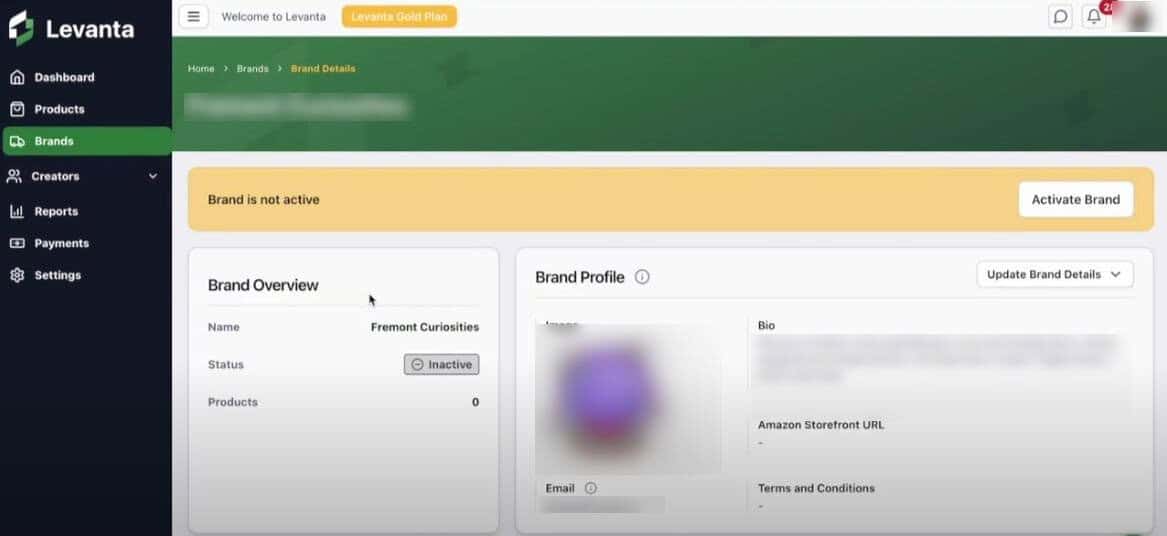
Setting up is super easy, in my opinion. You input details like your brand name, bio, email, and so on, and then connect Levanta to your Amazon seller account. You can manage several brands under one account. So, if you’re running different stores, you can quickly flip between them.
Even if you have hundreds of products, you’d be able to easily find the one you’re looking for. And if you have several stores, you can track the performance of each product without much effort.
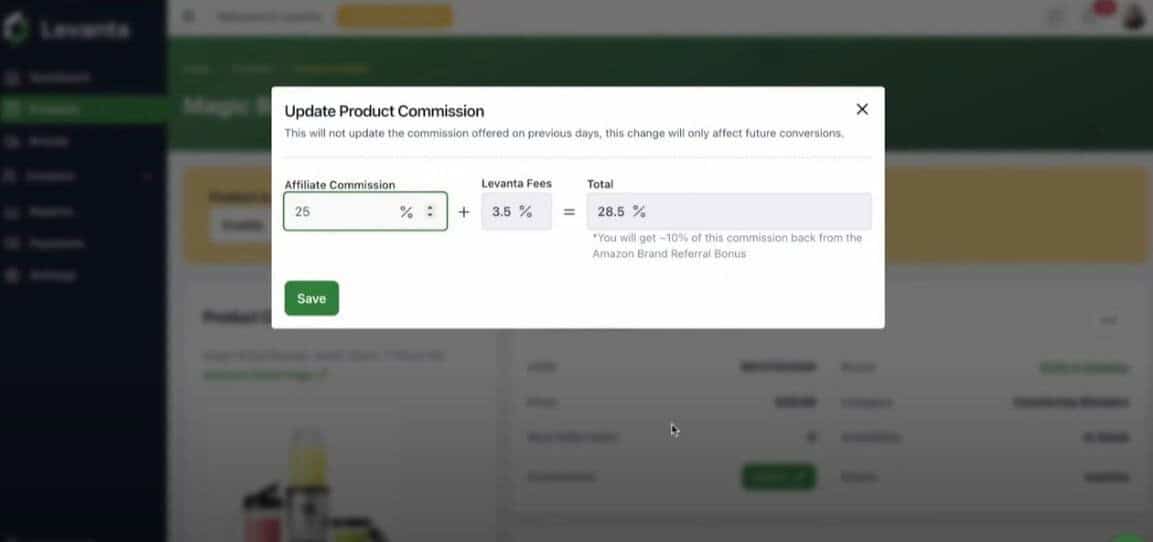
Managing products is also painless. I like the overview, which gives you a list of products and allows me to quickly search for something if I need to. You can set the amount of commission affiliates will get for each product, and Levanta automatically adds on their own fees to give you a total percentage.
I also tried using Levanta to set deals for products, and found it to be a useful and quick tool to adjust my pricing. For example, I can set up a Black Friday sale and have it automatically end at a certain time without having to go in and manually restore all the pricing.
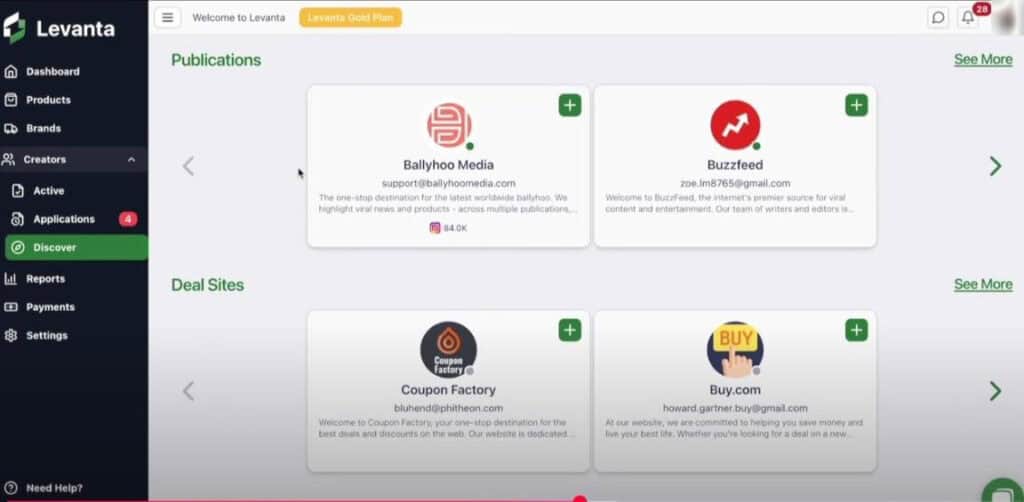
While Statusphere focuses specifically on matching brands with influencers, I prefer Levanta’s broader approach to affiliate marketing and partnerships. Instead of limiting you to one type of collaborator, Levanta brings everything into one platform: publications, deal sites, influencers, affiliate networks, commerce tools, and media buyers, giving you a full view of all the ways to grow and promote your products.
I think one of Levanta’s biggest strengths is the ability to filter through collaborators. You can be picky here. For example, you can decide only to use influencers with a certain number of followers. While it doesn’t automatically select influencers like Statusphere, it gave me a lot of control, which I appreciate.
Managing affiliates is simple; you can see your current applications, review them, reach out to new contacts and ask them to join your network, and quickly create a branded creator sign-up page. I especially like that last feature because it makes my branding feel cohesive and professional. Once they’ve signed up and you’ve approved their application, you can take advantage of the Product Seeding Program to get product samples to your creators, track how they’re doing, and to reach out to them when necessary.
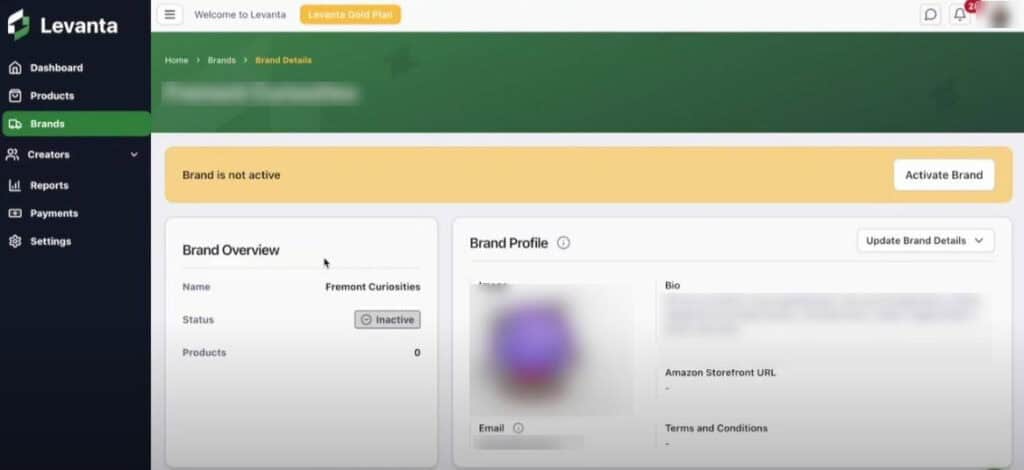
I like Levanta’s analytics, too. Simple stats like clicks, add to cart, conversions, and sales are easy to view, and you can go into them in greater depth via its ASIN-level tracking. I also like that you can manage your affiliates/influencers and check their progress easily. Statusphere is the same, but I like that all the contact with partners are under one umbrella with Levanta; you don’t need to spend time emailing everyone separately, and it makes it much easier for me to manage on my own. The only downside is that while Levanta includes some AI tools, you’ll need to choose and integrate additional ones yourself if you want more advanced automation.
The Bottom Line on Levanta
Levanta is designed for Amazon sellers (and sellers who want to diversify to Amazon), plus it’s great for managing your products, deals, and affiliates. I also like the amount of control it gives me, and I find it to be much more affordable than Statusphere. I think if you’re focused on Amazon, this is the best choice, because its ASIN-level tracking feature means you get comprehensive insights on your affiliate and influencer campaigns.
Levanta assembled this report to help digital merchants navigate the new AI-shaped buying journey. Discover why creators now drive the clicks AI can’t and how to turn that into revenue.
Statusphere vs Levanta: Which One Do You Need? My Final Verdict
As always with these comparisons, it’s all about what your specific needs are. It really comes down to what you’re trying to achieve.
Statusphere is best for brands that want a simple, automated way to get products into influencers’ hands. Its AI takes care of matching, messaging, and logistics, which makes it great for straightforward influencer campaigns. But it’s not built for tracking actual sales or managing complex partnerships, so if you need more than gifting and engagement, you’ll quickly hit its limits.
Levanta is built for eCommerce and Amazon brands ready to scale. It gives you full control to hand-pick who you work with, track performance down to individual products, and manage commissions and payouts in one place.
For me, Levanta is the clear choice for my Amazon store. It’s easy to use and connects directly to Amazon, so I can see exactly which products and partners are driving sales. I can manage everything, from performance tracking to payouts, without juggling multiple tools.
But again, that’s me.


